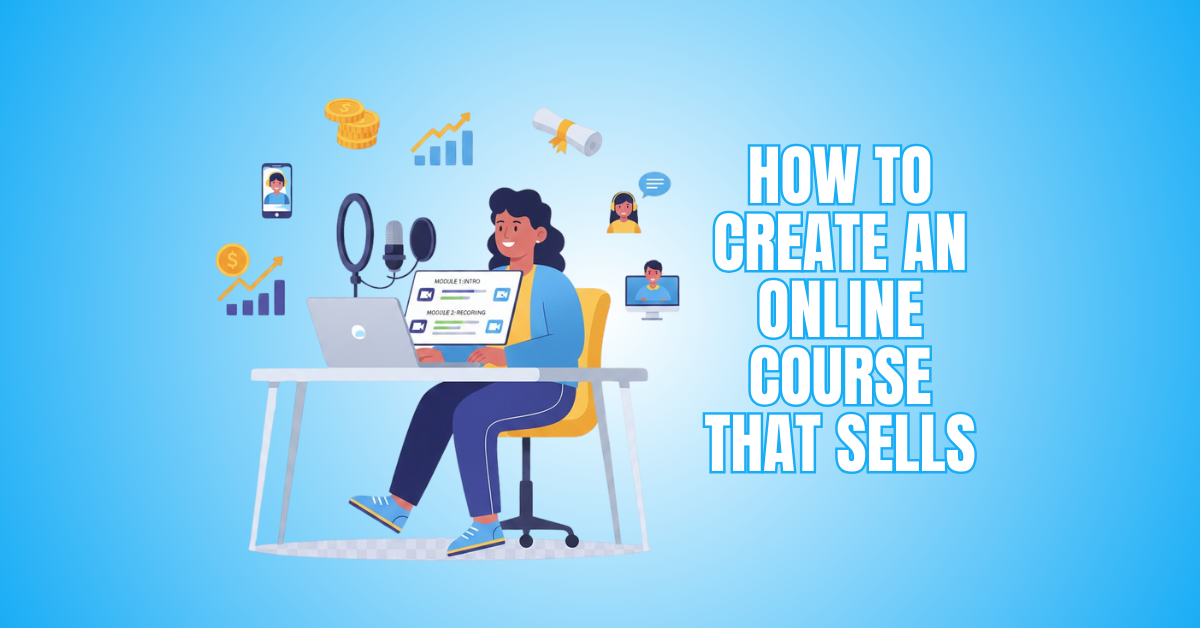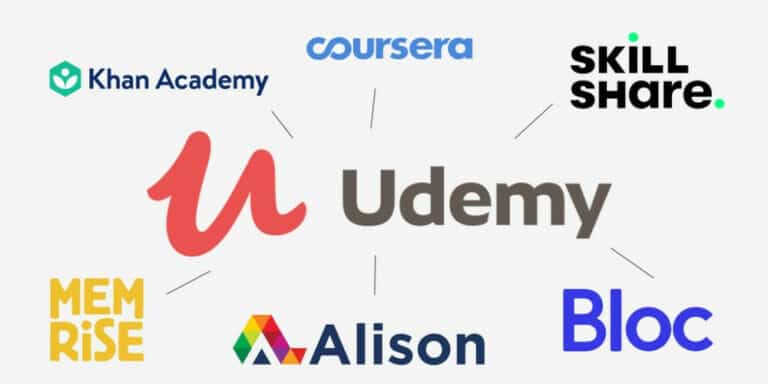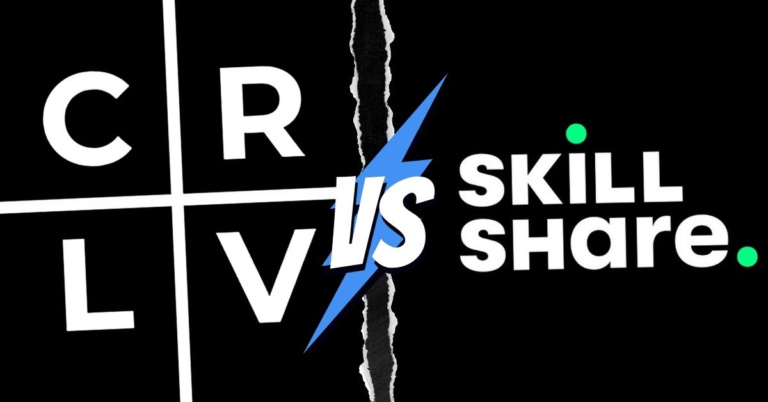How To Create An Online Course That Sells
Creating an online course that actually sells isn’t just about sharing knowledge. It’s about connecting with people, solving real problems, and designing a learning experience people feel excited to buy. The good news?
You don’t need to be a tech expert or a marketing genius to make it happen. You just need a straightforward process, the right tools, and a genuine desire to help your audience. In this guide, we’ll walk through every step of creating a profitable online course.
By following this step-by-step guide, you’ll learn exactly how to create an online course that sells and delivers real value to your students.
Why Are Online Courses So Valuable?
1. Flexible Learning Anytime And Anywhere
Online programs allow students to learn at their own pace. They can access lessons on their own schedule, pause, rewind, or skip sections, making education convenient for busy people, travellers or those balancing work, family, or other commitments.
2. Affordable Compared To Traditional Education
Compared to college degrees or in-person workshops, online courses are often far more budget-friendly. Students pay less yet gain high-quality knowledge. This makes education accessible to a broader audience while avoiding student debt or costly travel expenses.
3. Skill-Based And Practical
Most online courses focus on real-world, applicable skills. Whether it’s coding, marketing, design, or cooking, learners gain immediately usable knowledge.
This practical approach helps them solve problems, complete projects, or advance their careers faster than traditional theory-based learning.
4. Learn Directly From Experts
Students benefit from the knowledge and experience of industry professionals. Unlike traditional classrooms, they get insider tips, shortcuts, and real-life examples, allowing learners to absorb practical wisdom and guidance from someone who has successfully navigated the field.
5. No Travel Or Location Limits
Online courses remove geographical restrictions. Students from any country or city can access high-quality education without relocating or commuting. This inclusivity opens doors to global learning opportunities, connecting people with expertise they couldn’t access locally.
6. Rewatchable Content
Lessons can be replayed multiple times, helping students understand complex topics at their own speed. This reinforces learning, ensures better retention, and allows students to revisit material whenever they need a refresher, creating a more effective and supportive learning experience.
7. Fast Updates And Fresh Content
Online courses can be swiftly updated to incorporate new techniques, tools, or trends. Unlike textbooks or static classrooms, students receive the latest knowledge, keeping their skills relevant and competitive in fast-changing industries without having to enroll again.
8. Community And Support
Many online courses include forums, live sessions, or private groups where learners can ask questions, share experiences, and get support.
This sense of community enhances motivation, helps clarify doubts, and builds networking opportunities for future collaboration or mentorship.
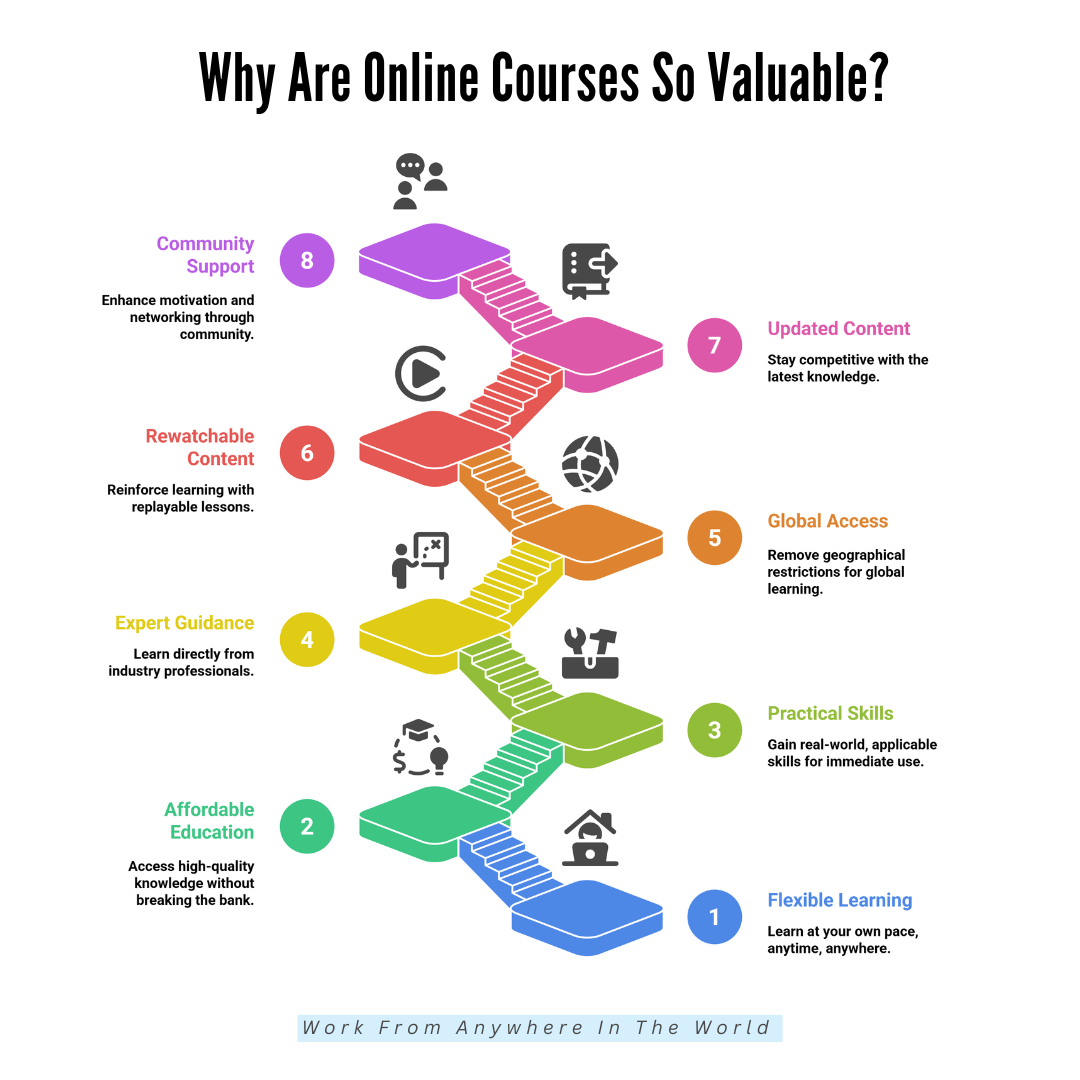
Step-By-Step Blueprint To Create An Online Course That Sells
1. Pick One Strong Outcome
Start by choosing one clear result your students will achieve by the end of your course. Keep it simple. Keep it focused. People buy outcomes, not information.
So think about the transformation your course will deliver. Ask yourself what real change your student will experience. Will they gain a new skill? Solve a frustrating problem? Save time? Make money? Become more confident?
When you define one strong outcome, your entire course becomes easier to structure. Lessons flow better. Students stay motivated. And your marketing becomes sharper. A focused outcome creates a focused, high-value course.
Pro Tips
- Make the outcome extremely specific.
- Focus on one fundamental change.
- Keep wording simple.
- Align outcome with demand.
2. Choose A Specific Audience
Now it’s time to choose precisely who your course is for. Be specific. Don’t target everyone. When you narrow your audience, your message becomes clearer. Your examples make more sense.
And your lessons feel more personalized. Think about the group that needs your solution the most. What are their struggles? What do they want to learn quickly? What transformation are they chasing?
When you focus on a specific audience, your course becomes easier to sell. People connect to something that feels tailored to them. The right audience makes your course stronger and far more profitable.
Pro Tips
- Define the audience with precision.
- Identify their core struggle.
- Match course to needs.
- Speak their language always.
3. Validate The Idea
Before creating your course, check if people actually want it. Validation saves time and prevents wasted effort. Ask your audience through surveys, polls, or social media questions. Run a small paid workshop or pre-sell the course.
If people pay, you know the idea has value. If not, adjust the topic or outcome. Testing ensures your course solves real problems. Validation also gives confidence for marketing and pricing.
Knowing there’s demand prevents frustration later. This step reduces guesswork and ensures your course will resonate. Build something people genuinely need and want.
Pro Tips
- Test demand before creating.
- Use polls for clarity.
- Pre-sell to confirm interest.
- Adjust based on feedback.
4. Research Competitors And Gaps
Study similar courses in your niche. Look at what they offer and how they teach. Conducting competitive research helps you understand the market and learn precisely how to create an online course that sells by filling gaps others overlook.
Notice gaps in clarity, engagement, or support. Your goal isn’t to copy but to improve. Offer solutions that others overlook.
Simplify complex topics or explain steps more clearly. Fill these gaps to create a unique, valuable course. Standing out makes students choose you.
Competitive research ensures your course delivers what others don’t. Focus on clarity, relevance, and results to make your course more attractive and trustworthy.
Pro Tips
- Study winners in a niche.
- Identify missing elements clearly.
- Improve what others overlook.
- Make the solution simpler always.
5. Map The Student Journey
Visualize the student’s path from start to transformation. Break the journey into manageable steps. Think about the milestones students need to reach the end goal.
Each step should be achievable and motivating. A clear learning path reduces confusion and keeps learners engaged. Mapping ensures lessons flow logically.
It also helps with structuring modules, exercises, and resources. Consider challenges students might face and plan solutions. This roadmap gives a sense of direction and progress.
A well-defined journey makes the course easier to follow and more likely to deliver results. Clear paths create confidence and trust.
Pro Tips
- Plan steps logically.
- Keep the journey very simple.
- Avoid overwhelming students.
- Build a smooth learning flow.
6. Create A Module Outline
Divide the student journey into modules, like chapters in a book. Keep modules focused and concise. Aim for 4–7 modules to prevent overload.
Each module should cover a significant stage of transformation. Inside modules, break topics into short, actionable lessons. This makes learning easier and keeps students engaged.
A strong outline guides content creation, recordings, and resources. It ensures lessons flow naturally. Students appreciate clear structure, and it improves retention.
Modules also simplify marketing by showing precise results. Outlines make your course professional, manageable, and easier to complete successfully.
Pro Tips
- Keep modules tightly focused.
- Use short, clear lessons.
- Follow natural learning order.
- Avoid unnecessary content altogether.

7. Write Lesson Objectives
Before recording, define what each lesson will achieve. Objectives should be short, clear, and measurable. Ask: “What must the student understand or do after this lesson?” Objectives guide your teaching and keep content relevant.
Students value lessons with clear takeaways. Measurable objectives also help with assignments, worksheets, and quizzes.
They ensure each lesson contributes to the overall transformation. Clear objectives make your course professional and easier to sell.
They also allow marketing to highlight benefits confidently. Every lesson should have a purpose, making your course structured, consistent, and outcome-focused.
Pro Tips
- Make objectives measurable.
- Focus on one takeaway.
- Keep wording very simple.
- Ensure alignment with the outcome.
8. Choose Formats And Tools
Decide how you will deliver content: video, slides, audio, screen recordings, worksheets, or templates. Match the format to your topic and comfort level. Don’t overcomplicate; simplicity is better than perfection.
Choose user-friendly recording and editing tools. Tools like Loom, OBS, or Canva make lessons easier. Your focus should be teaching, not tech. The format should enhance learning and make concepts clear.
Efficient tools save time and reduce frustration. When students find lessons accessible, they engage better. Choose formats that support action, retention, and comprehension for a practical course experience.
Pro Tips
- Choose simple tools first.
- Match format to content.
- Avoid complex setups always.
- Prioritize clarity over design.
9. Script Or Storyboard Lessons
Planning and storyboarding your lessons carefully is a key step in learning how to create an online course that sells and engages students effectively. Include main ideas, examples, demonstrations, and one action step.
Storyboarding helps visualize slides, screens, or exercises. Structured lessons keep students focused and motivated. This reduces mistakes, saves editing time, and ensures smooth delivery.
Scripts also help convey concepts clearly. Short, actionable lessons improve retention. Preparation boosts confidence during recording.
A clear plan ensures students can follow along and get results quickly. Well-organized lessons feel professional, effective, and easy to implement.
Pro Tips
- Outline the main idea first.
- Add one action step.
- Keep explanations very short.
- Visualize the flow before recording.
Wealthy Affiliate – Mini Review (2025)
If you’ve ever thought about turning your blog, passion, or niche into an online business,
Wealthy Affiliate (WA) is one of the most beginner-friendly platforms I’ve used.
It combines step-by-step training, website hosting, SEO research tools,
and an active community all in one place.
What I like most: you can start free (no credit card needed),
explore lessons, test the tools, and connect with other entrepreneurs
before upgrading. WA isn’t a “get rich quick” scheme — it’s a platform where success comes
from consistent effort and applying what you learn.
10. Record And Edit Efficiently
Record lessons in a quiet space with good lighting. Use simple equipment like a webcam or phone and a microphone. Speak clearly and keep lessons concise. Mistakes can be fixed during editing.
Use software like Canva, iMovie, or OBS for trimming and adding slides. Focus on clarity, not perfection. Natural delivery feels confident and relatable. Short videos are more interesting and easier to watch.
Efficient recording reduces stress and speeds up creation. Students appreciate lessons that are easy to follow and actionable. Prioritize content quality over flashy production.
Pro Tips
- Use simple recording gear.
- Keep videos short, always.
- Edit only essential parts.
- Prioritize clarity over polish.
11. Create Support Materials
Provide worksheets, templates, checklists, or quizzes. These help students apply lessons quickly. Support materials make complex topics easier to understand.
They add value and improve retention. Focus on actionable, relevant resources. Avoid unnecessary extras that confuse students. Worksheets and templates can turn theory into practice.
Materials also increase perceived course value. Students love tools they can immediately use. Good support materials make implementation faster and results more consistent.
They also improve testimonials and referrals. Include only what directly enhances the learning experience and transformation.
Pro Tips
- Add only helpful resources.
- Keep worksheets very simple.
- Create tools for action.
- Increase value with templates.
12. Pick A Hosting Platform
Selecting the best hosting platform is a crucial step in developing an online course that appeals to students and offers a seamless learning experience.
Options include Kajabi, Teachable, Podia, Thinkific, or WordPress with LearnDash. Consider your budget, tech skills, and desired control. Look for payment options, quizzes, email integration, and a clean design.
Don’t pick the fanciest system; choose what works for you. The platform should make access simple for students. Smooth delivery improves engagement and completion rates.
Reliable platforms reduce technical issues. Ease of use helps both creators and students. The right platform supports growth, marketing, and consistent student experiences.
Pro Tips
- Choose a beginner-friendly platform.
- Match features to needs.
- Avoid overly complex systems.
- Prioritize student experience always.
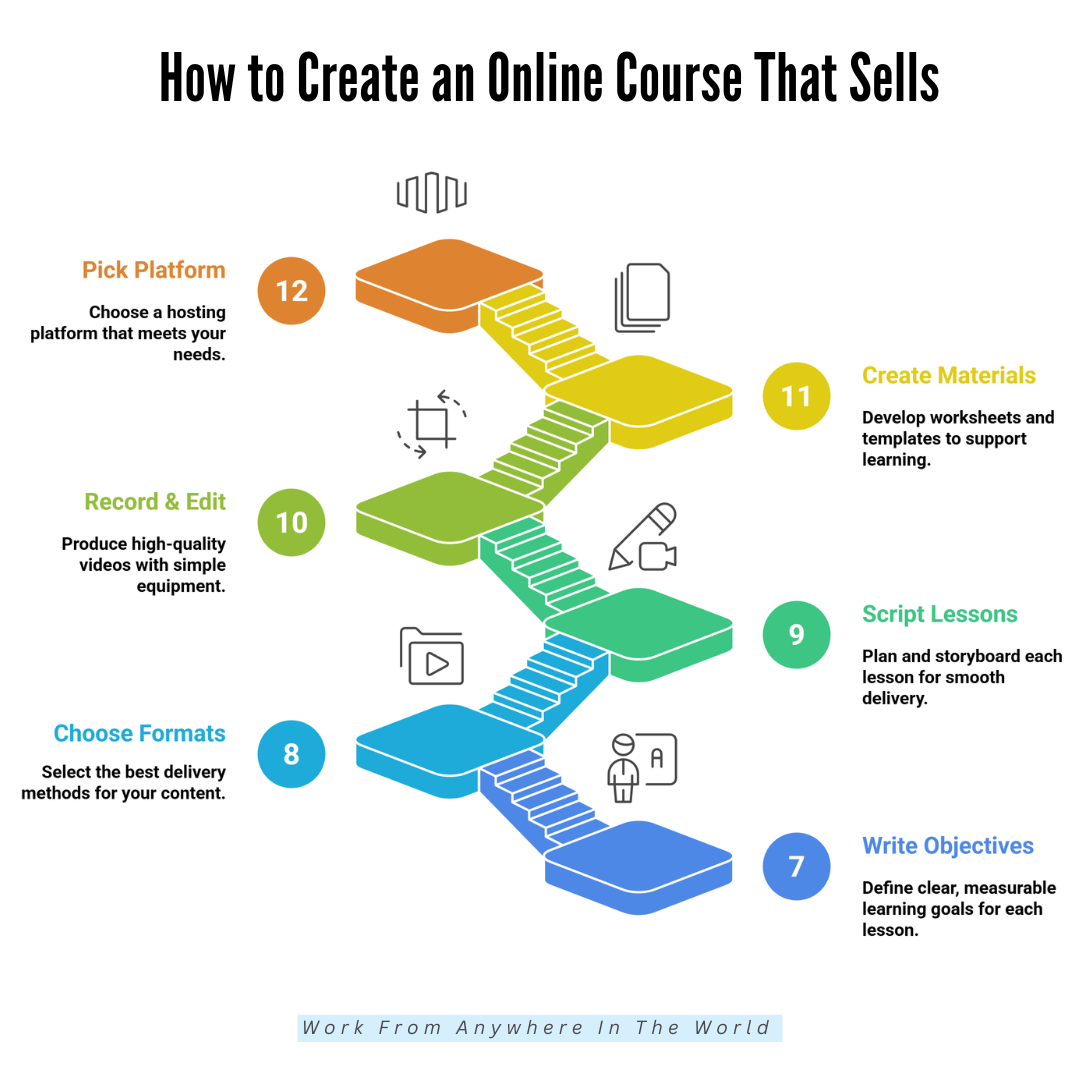
13. Set Value-Based Pricing
Price your course based on the transformation, not length. Consider the results, time saved, or income generated for students. Use tiered pricing for extra features or coaching. Payment plans make courses accessible.
Don’t underprice out of fear; value builds trust—a confident price positions your course as serious and valuable. Compare similar courses for context, but focus on your unique outcome.
Strong pricing communicates authority. Avoid constant discounts, which can devalue your course. Price fairly, confidently, and based on the results students will achieve, ensuring both profit and credibility.
Pro Tips
- Price for transformation value.
- Offer flexible payment plans.
- Avoid discounting too often.
- Believe in your outcome.
14. Build A High-Converting Sales Page
Your sales page should clearly communicate the transformation. Start with a strong headline. Show main benefits and module breakdowns. Include testimonials, screenshots, or results. Address objections simply.
End with a clear call to action. Keep copy conversational and approachable. Avoid jargon or clutter. Highlight outcomes over features. Use visuals to enhance understanding.
A strong page builds trust, demonstrates value, and encourages enrollment. Keep navigation simple and focused. Your sales page should guide students from curiosity to confident purchase, showing exactly why your course is the solution they need.
Pro Tips
- Lead with transformation.
- Use simple persuasive language.
- Add emotional proof examples.
- End with a strong CTA.
15. Create A Lead Magnet And Funnel
Using lead magnets and nurturing your audience is a powerful strategy to understand how to create an online course that sells and attracts eager students.
This could be a checklist, mini-course, template, or guide. Use it to build an email list. Nurture leads with valuable content before selling.
Share tips, stories, and mini-wins. When your course launches, these warm leads are more likely to purchase. Funnels build trust and engagement over time.
Keep the funnel focused and straightforward. Lead magnets also position you as an expert. A strong funnel grows your audience and ensures consistent course sales.
Pro Tips
- Offer a practical freebie quickly.
- Keep the funnel simple, always.
- Share value before selling.
- Nurture the list consistently.
16. Plan A Simple Launch
A launch doesn’t need to be complicated. Tease your course on social media and via email. Build anticipation. Offer early-bird bonuses or discounts.
Keep the enrollment window short. Send clear emails explaining benefits and outcomes. Remind potential students before the cart closes.
Make the launch friendly, helpful, and exciting. Focus on clarity, not pressure. Track engagement to optimize future launches.
A simple, well-planned launch drives early sales and builds momentum. Properly executed, it creates excitement, student trust, and high enrollment without overwhelming you or your audience.
Pro Tips
- Tease content early.
- Offer limited-time bonuses.
- Send clear launch emails.
- Keep the launch window short.
17. Promote Consistently
After launch, keep promoting your course. Share helpful tips, short videos, and success stories. Use blogs, social media, emails, and collaborations. Consistency builds trust and visibility. Repurpose lessons into multiple formats.
Don’t sound pushy; focus on value. Show results from current students. Frequent, valuable exposure increases long-term sales. Consistent promotion keeps your course relevant.
Regular content also builds authority and credibility in your niche. Over time, your audience grows organically, creating a sustainable income stream and positioning your course as a trusted, reliable solution.
Pro Tips
- Share value consistently.
- Repurpose content weekly.
- Show real student wins.
- Promote softly, helpfully.
18. Onboard Students Well
Welcome students with clear instructions and friendly communication. Provide a quick-start guide or orientation video. Explain what to expect and how to access resources.
Encourage early engagement and participation. Set expectations for the course journey. Onboarding boosts confidence and completion rates.
Provide support channels and clarify common questions. Make students feel valued and supported. A smooth onboarding process reduces confusion and frustration.
Good onboarding sets the tone for the course and ensures students start strong. Engaged students are more likely to finish and share positive reviews.
Pro Tips
- Send a warm welcome email.
- Provide simple first steps.
- Offer support channels clearly.
- Encourage early engagement.

Conclusion
Creating an online course that truly sells requires careful planning, focus, and execution. By following proven strategies and focusing on student transformation, you can master how to create an online course that sells and delivers lasting results.
When you prioritize value, clarity, and student success, your course becomes more than lessons—it delivers transformation. Feedback, social proof, and ongoing improvements ensure long-term results.
With dedication and strategy, anyone can build a course that educates, inspires, and generates sustainable income. Start small, stay focused, and keep evolving.
I trust you enjoyed this article on the [Blog Post Title]. Please stay tuned for more insightful blogs on affiliate marketing, online business, and working from anywhere in the world.
Take care!
— JeannetteZ
💬 Your Opinion Is Important To Me
Do you have thoughts, ideas, or questions? I’d love to hear from you. Please leave your comments below or email me directly at Jeannette@WorkFromAnywhereInTheWorld.com.
📚 More Work From Anywhere Reads
🚀 Ready to Build a Business You Can Run from Home
Or from Anywhere in the World?
Imagine creating income on your terms — from home, a cozy café, or wherever life takes you.
With the right tools, training, and community support, it’s entirely possible.
Start your own online business for free — no credit card needed.
Disclosure
This post may contain affiliate links. As an Amazon Associate and participant in other affiliate programs, I earn from qualifying purchases at no extra cost to you. Please read my full affiliate disclosure.

